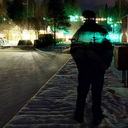8 Likes
There is something very special about the shallow lagoon sand and coral flats of New Caledonia. You'd think there would not be much of interest here and in fact very few people visit these areas. Unless it is high tide you can't even swim over the top of the coral thickets and it's about breast deep if you stand up on the soft white sand.
But this is an experience not to be missed. It is a world of sea life in miniature where, amid the branches of the corals, you see the reef fish when they are still just teeny weeny spots of color. Schools of fish - all less than 20mm long - flash just under mirror-like surface of the lagoon. They are so small even the birds ignore them. If you peer closely at a dark place on the corals and you are likely to see larvae of reef creatures that are less than a millimeter long dancing like mayflies in the prismatic flashes of sunlight. Because it is so shallow, the colors are just amazing.
There are thousands of square kilometers of these coral reef nurseries on the shoal areas around the coral islets and New Caledonia's Great Barrier Reef (the second largest barrier reef in the world). Big waves rarely reach the nurseries so the corals themselves are very delicate and beautiful. The labyrinth of shallow corals discourage reef predators from patrolling for munchies. In any case, the fish are very small and hardly worth the effort for most reef fish. Plus they are hard to catch. When anything big comes by, the tiny fish withdraw into the protective branches of the coral. And at night the fish tuck themselves deep into the coral branches to sleep.
I never could have taken this image if I was actually there myself. The fish vanish into the corals as soon as I approached. The distance from the camera to the coral thickets was about 400 mm even less on one side - there was barely room for me to set up the underwater robot camera on the sand before I swam away - looking around at all the beauty and hoping the fish would relax and come out and play as soon as they saw me leave.
According to the images captured by the robot, the little fishies worried about the camera for about 20 minutes then they ignored it. The camera was able to capture them as they hovered over the corals munching on plankton that floated by in the current or chasing each other around the coral. A couple of the fish were curious and came nice and close to the camera to have their portraits taken.
Predators do get into the nursery - like the stingray you can see munching on clams in the sand. And I did see a sea snake looking for breakfast. I also saw tiny groupers no doubt learning their predatory skills in this miniature reef world.
...





New Caledonia is the closest South Pacific Island to Australia and New Zealand. It is a French Territory and although the official language is French the culture is a blend of Melanesian, European, Polynesian, Vietnamese, Chinese, Indonesian, and more. There is one large mountainous island called Grande Terre and 6 smaller islands - the three Loyalty Islands, Belep and the Isle of Pines.The islands are remarkably unpopulated and there are vast areas of wilderness. There are hundreds of kilometers of walking treks, camp grounds, more than 42 parks and reserves, and crystal clear rivers with sparkling waterfalls. Almost one third of the population is located in the capital city of Noumea. Nickel mining is the primary industry and is the major contributor to the high standard of living in the country. Grande Terre is surrounded by the second largest barrier reef in the world and the protected lagoon created by this barrier reef is the largest in the world. Listed as a World Heritage Site in 2008, the lagoon is 24,000 square kilometers and supports a diverse and luxuriant fauna of fish and invertebrates.The vibrant, clear and rich colors are one of the first things that visitors notice when they arrive. Noumea has a complete range of hotels, resorts, restaurants, and activities to welcome visitors.